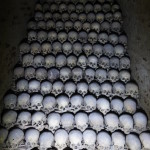
During our stay in Prague, we had two chances to meditate on death, or rather meditate on meditations on death. This is not our usual habit while touring, but we were encouraged to do so at two ossuaries featuring artful arrangements of the bones of thousands of people dating back many hundreds of years.
Many know of the catacombs in Paris or the Capuchin crypt in Rome. In Paris, late 18th century urban renewal efforts led to a clean up the old city cemeteries, where the dead had been buried en masse for ages. The bones of the buried were transferred to a central spot, a cavern where they could lie without disturbing new construction. The brooding, Romantic period that followed brought with it an interest among the public for viewing what was left of the dead. In Paris, those in charge decided to arrange in entertaining displays the displaced bones and what interesting gravestones had survived. Similarly around European churches and monasteries, other ossuaries opened their gates to popular interest.
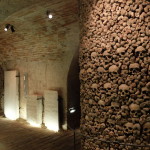
The first ossuary we visited, in Brno, resulted from a reburial effort similar to Paris’. The remains of around 50,000 people ended up below the vast plaza around the Church of St. James, the second largest collection of skeletons in Europe. (To read the post, click here.) In this case, though, it wasn’t until construction work at the end of the 20th century that the bones were re-discovered though they had been resettled a few hundred years earlier. A modest number were then arranged in a mini-catacomb to attract tourists. Across town, one can also visit a smaller scale display of mummified bodies and bones at the Capuchin monastery.
Clearly tourist offices today recognize that ossuaries remain fascinating to visitors. The why seems obvious. Some of us like their oddity, displaying what’s left over many years after death instead of the modern western style of hiding the dead away. Now, in remembering the dead, we aim to recall them as they lived via photographs or film, even on the gravestone itself.
Others are attracted to the creepiness of all those rearranged bones, secretly sharing in a violation of a taboo, one that attracts and disturbs. On one hand, seeing these bare bones is a thrill; on the other hand, perhaps these are best left hidden, and certainly not arranged decoratively.
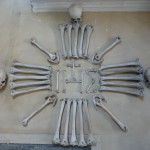
Exposing us to bones dates back way before all these tourist curiosities, at least to the Middle Ages. The Christian church aimed to remind people how imminent death would be so they would prepare religiously for an afterlife in heaven. The material world, it preached, with all your possessions, vanities or sensual pleasures, is fleeting; death is eternal and serious business. The skeleton, remember, abandoned by living tissue and the soul, is the only thing that survives your life on earth. All else is lost.
In Latin, the lesson of the bones was called “memento mori,” remember that you die. Or as the ossuary in Evora put it, “We bones, lying here bare, await for yours.”
The lesson of the bones is not a surprising one. And there are plenty of echoes from the Bible such as the valley of bones in which Ezekiel was shown the potential for revival and restoration.
The hand of the Lord was upon me…and set me down in the midst of the valley which was full of bones…: and, behold, there were very many in the open valley; and, lo, they were very dry.
This episode is the source of that gospel song, Dem Bones, which includes its own inventory of skeletal linkages…”the hipbone is connected to the thigh-bone” and so on.
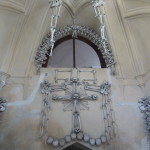
Through the Middle Ages and Renaissance, artists and poets echoed the church, frequently working skulls and skeletons into their works to depict life’s ephemeral quality and the vanity of human endeavors. Skulls in particular were useful to stir meditations on life or afterlife. Shakespeare’s Hamlet finds the skull of his playmate Yorick, as if he needed more moodiness, and then meditates on the shortness of life. Of course, no person is spared, whatever their profession or class in society. They are all united in the dance of death, another trope of the period where all are forced to dance to death’s tune.
These themes naturally continue to haunt philosophy and art, but the fashion for the harsh message of memento mori changed over time, perhaps because our vanities became more important to us or religious messages turned less austere.
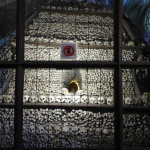
One surviving tradition is Mexico’s Day of the Dead when skeletal bones even have their own day. The bones displayed are rarely actual, but more fanciful renderings, as better befits a party instead of a lugubrious reminder of mortality. And in the Philippines, Christian traditions and ancient tribal practices resulted in their own memorial use of bones. Coffins adorned with bones hang precipitously in limestone niches in the Luzon mountains. To honor and remember their ancestors, families exhume their skeletons and perform a second burial, storing the bones in a cloth sack or urn within their homes. (Click here for more about this.)
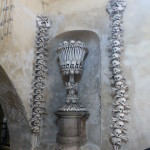
So we were surprised, at the ossuary in Sedlec on the outskirts of the old mining town of Kutna Hora, to find more than just a decorative display, but rather the memento mori caveat fully fleshed out. By 1870, Frantishek Rint arrayed tens of thousands of bones from Sedlec’s church cemetery. The collection imitates Paris and Brno in piling up bones; there are several pyramids of skulls and bones that demonstrate the huge numbers of skeletons found.
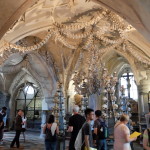
But the primary design recalls memento mori in a dazzling way. As you enter the forechamber of the crypt, you see walls adorned with typical Christian emblems and crosses, yet all formed out of bones, Then in the main chamber, in the midst of the pyramids, you find a kind of ballroom meticulously re-created by Rint, complete with a massive chandelier, torch stands, flower urns, wall decorations, and festoons strung across the space – all formed out of bones.
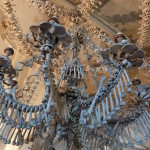
Parts can be morbidly funny, as in the placement of Baroque angelic babies atop the stands or the petal-shaped candleholders made by overlapping about a dozen small hip-bones, each topped with a skull and an actual candle. Renaissance men and women who understood the call to memento mori would well understand this ballroom’s ironic admonition against dancing your soul away in vain pleasures.
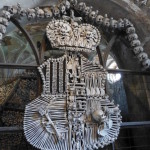
One other pointed memento mori creation is the two-meter high heraldic shield in one corner of the large room, a lively and wondrously clever display of bones. On the shield, bony heraldic symbols are backed by a kind of threadwork of small finger and arm bones. A superb tri-partite crown tops the shield, made of three skulls, each of which is set in a fan-like array of hipbones. At its bottom, a row of tail-bones underlines the crown. Above the shield, a cross made of leg-bones underscores the point. High or low class, all must face death; castles, honors, possessions all will be gone.
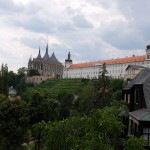
There’s a lot more going on in Kutna Hora than bony sermonizing, as befits a World Heritage Site. This was both a silver mining and minting town as far back as the 13th century so many wealthy courtiers and not so wealthy workers lived here over the centuries (ending up, presumably, in the ballroom at Sedlec). You can still visit mines and museums here to learn their stories.
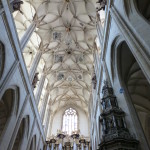
The wealthy built a lot of fine churches to earn merit with the church. The largest and most splendid of these dates from the14th century, the Church of St. Barbara, honoring the patron saint of miners. Its unusual three peaked roof, like three inverted trumpet horns, protect a lovely interior of interlaced ceilings and attractive Renaissance frescoes, including some of miners at work.
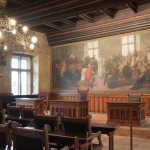
Nearby the finest municipal building is the Vlassky Dvur, or Italian Court because of its Italianate design. This rambling structure housed minting operations and storage of ore, but also served as a castle for King Wenceslas IV and then later as a town hall. Different parts of the structure show off its whole history: from Wenceslas’ exquisite royal chapel, albeit with more modern decoration, to the minting operations, to the impressive meeting chamber of town leaders.
But it’s the bones over at Sedlec you find hardest to forget.
(Also, for more pictures from Czech Republic, CLICK HERE to view the slideshow at the end of the Czech Republic itinerary page.)


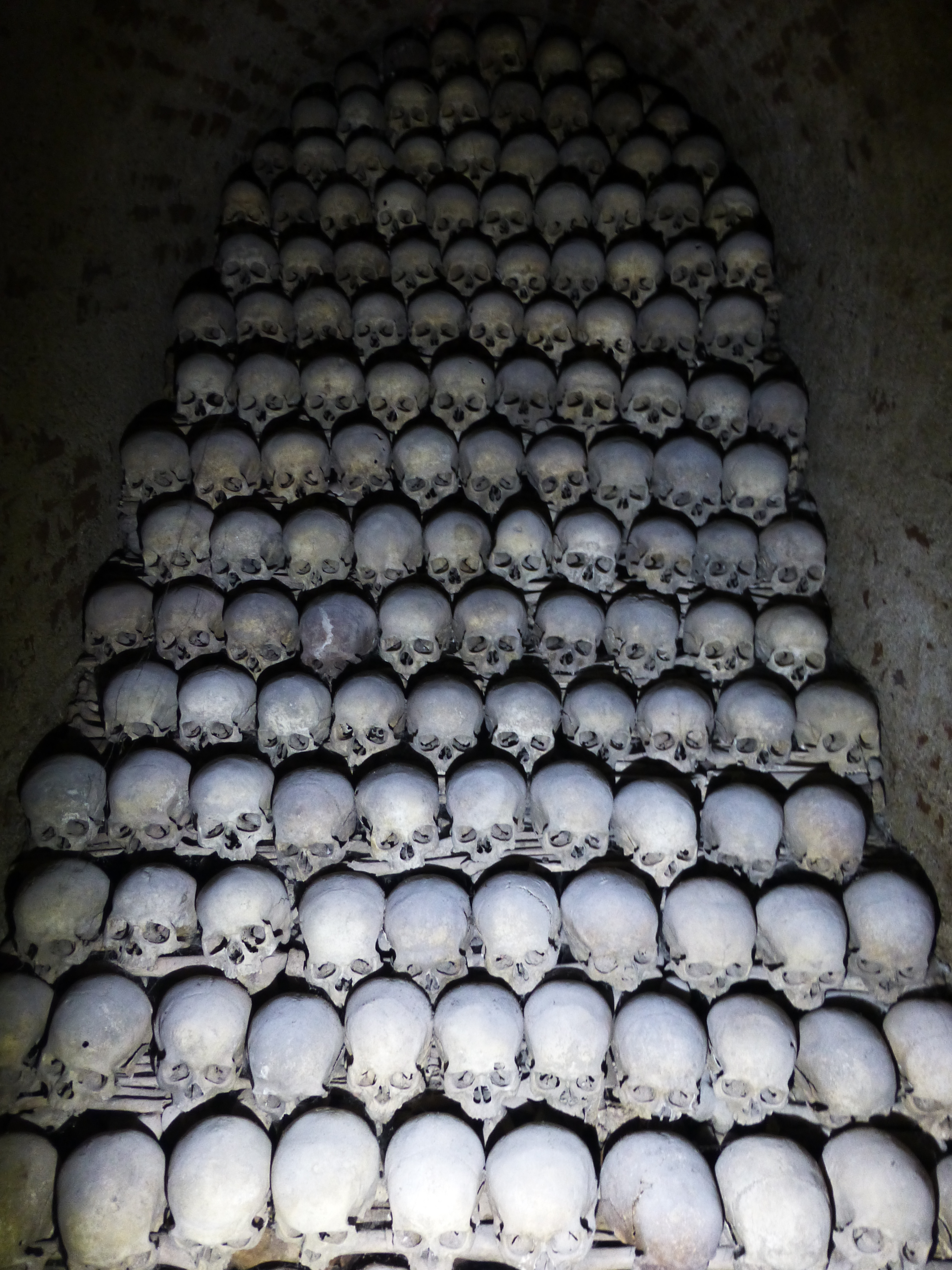
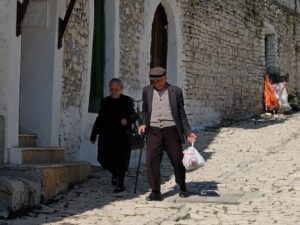

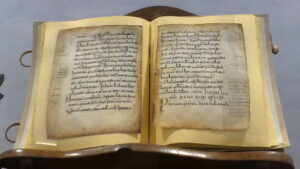
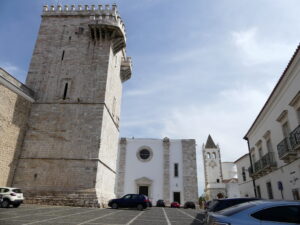
That bone chandelier is the craziest thing I’ve ever seen
We’re always stunned at what people can come up with for materials and design across the world.